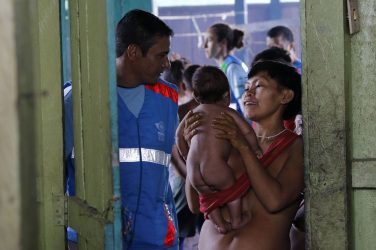With an historical framework dating back over the past several decades and predominantly universalized, the Brazilian healthcare system remains comprehensive yet aspirational in its goals for the administration and implementation of policy for the nation’s greater populace.
The history of Brazil’s healthcare system is relatively recent. Although the structure and formation can be traced back to the early 1950’s (the founding of National Ministry of Health in 1953), 1960’s and 70’s (with healthcare reforms under the dictatorship), the fundamental format of healthcare was formally developed with the Movimento Sanitário initiative during the 1980s, and promulgated under the 1988 Constitution.
The Sistema Único de Saúde (SUS) remains the backbone of the Brazilian system. With a universal public system guaranteeing citizens’ rights to basic healthcare, a SUS identification card provides Brazilians with medical access and benefits.
Administered by National Supplemental Health Agency (ANS) and the National Health Surveillance Agency (ANVISA) and under the supervision of the Ministry of Health, SUS’s significance cannot be overstressed, defining both national structure and policy since its inception, and for well over three decades.
While municipal governments generally assume responsibility for SUS’s administration particularly with the Family Health Program, at the local level the Unidades Básicas de Saúde (UBS) have proved to be instrumental in SUS’s functioning.
Although it spends comparatively less on healthcare than its neighbors, by and large, Brazil remains the largest healthcare market in Latin America. Statistics compiled by the trade.gov country commercial guide in January of 2022 reveal 9.1% of GDP spent on healthcare, with approximately 6,642 hospitals (of which 63% are private), 502,000 physicians, and 89,000 drug stores.
Accordingly, SUS provides health services to 70% of the domestic population, and private health insurance is voluntary, with about 25% of the populace (more than 50 million) subscribing to private insurance, second only to the United States. Doctors’ fees, hospitalizations, and prescription drugs are all covered under the SUS system.
Certainly, the COVID pandemic has provided the most recent and greatest challenge to the Brazilian healthcare system over the past several years. While there has been debate over the effectiveness of the Bolsonaro government’s attention and administration, by and large, COVID policy was a success.
By January 2022, Brazil had vaccinated 70% of its population, and has continued its attempts to treat diseases such as dengue, malaria, and zika, which have lingered much longer in the country.
And there have been some admirable PHC (Primary Healthcare) initiatives over the years, particularly under Rousseff with the Mais Médicos Program of 2013, when more than 18,000 Cuban doctors were sent to rural Brazil to administer to the indigenous and indigent. The Mais Médicos Program highlights the challenge of attracting doctors, nurses and community health workers to quilombos, and poor and remote areas of the country.
Although the 30 years since the creation of SUS has witnessed marked gains in the administration of healthcare, particularly with life expectancy increasing from 70.2 in 2000 to 75.9 years in 2019, a myriad of fundamental challenges remain.
Despite an admirable presence of staff and ambulances, no number for emergency calls exists, and emergency care remains ad hoc, with the Brazilian Emergency Medical Service (SAMU) undertrained to deal with violence and road accidents.
Most significantly, Brazilian healthcare is marked by regional disparity, particularly in the poorer northeast which has high maternal mortality rates. With long waiting times, patients often do not pay their bills, and SUS funding has been insufficient.
The deficit in private-public sector healthcare coordination, shortages of medicines, and poor working conditions for health professionals are also problems, and foreigners visiting Brazil do not always find English-speaking doctors.
Furthermore, few Brazilians register with primary care physicians, hospital bed occupancy is low, access to medications is often limited, and the collection of health data is often scant. Here, what is at stake is healthcare’s basic systemic resilience, reacting to defining national economic and political factors which determine austerity policies and the fate of the aging Brazilian populace.
For Brazilian healthcare, then, a number of fundamental goals remain. A 2021 OECD Review of Health Systems highlights the need for increasing public funding for SUS, reconfiguring small hospital administration into intermediate care facilities, improving access to medications, transitioning to formal long-term care delivery, and strengthening the health care data infrastructure and information system. Brazil must also tackle problems of obesity and alcohol consumption, which have contributed to a high rate of premature deaths in the recent past.
For the soon to be inaugurated Lula administration, technological leverage and telemedicine, private insurance consolidation, and entrepreneurial pluck may very well be the solutions to healthcare implementation.
It will certainly take money. With the challenge of the pandemic, telemedicine has taken off, and will likely define the future of access to care for much of the population, for consultation, diagnostics and treatment.
The PT has generally been supportive of initiatives in social spending and poverty alleviation, and healthcare will remain a priority for the reelected president, but again, the main challenge will be the ability to fund SUS.
Lula could very well perpetuate the comprehensive 2020 Programa Médicos pelo Brasil, but ultimately economic and social disparity will continue to characterize the country’s disposition, reflective of an essential cleavage between richer private and poorer public access. While the possibility for gains in healthcare remains for Brazilians, the new president certainly has his work cut out for him.
Peter Sufrin holds a Master’s Degree in History from Boston University, a Master’s Degree in Diplomacy and International Relations from Seton Hall University, and a Master’s Degree in Portuguese from the University of Massachusetts/Dartmouth. He is an Associate Member of the Inter-American Dialogue in Washington, D.C. and contributes regularly to the Dialogue’s Latin America Advisor, the Brazilian Report, American Diplomacy, The Georgetown Journal of International Affairs, and to Brazzil.














